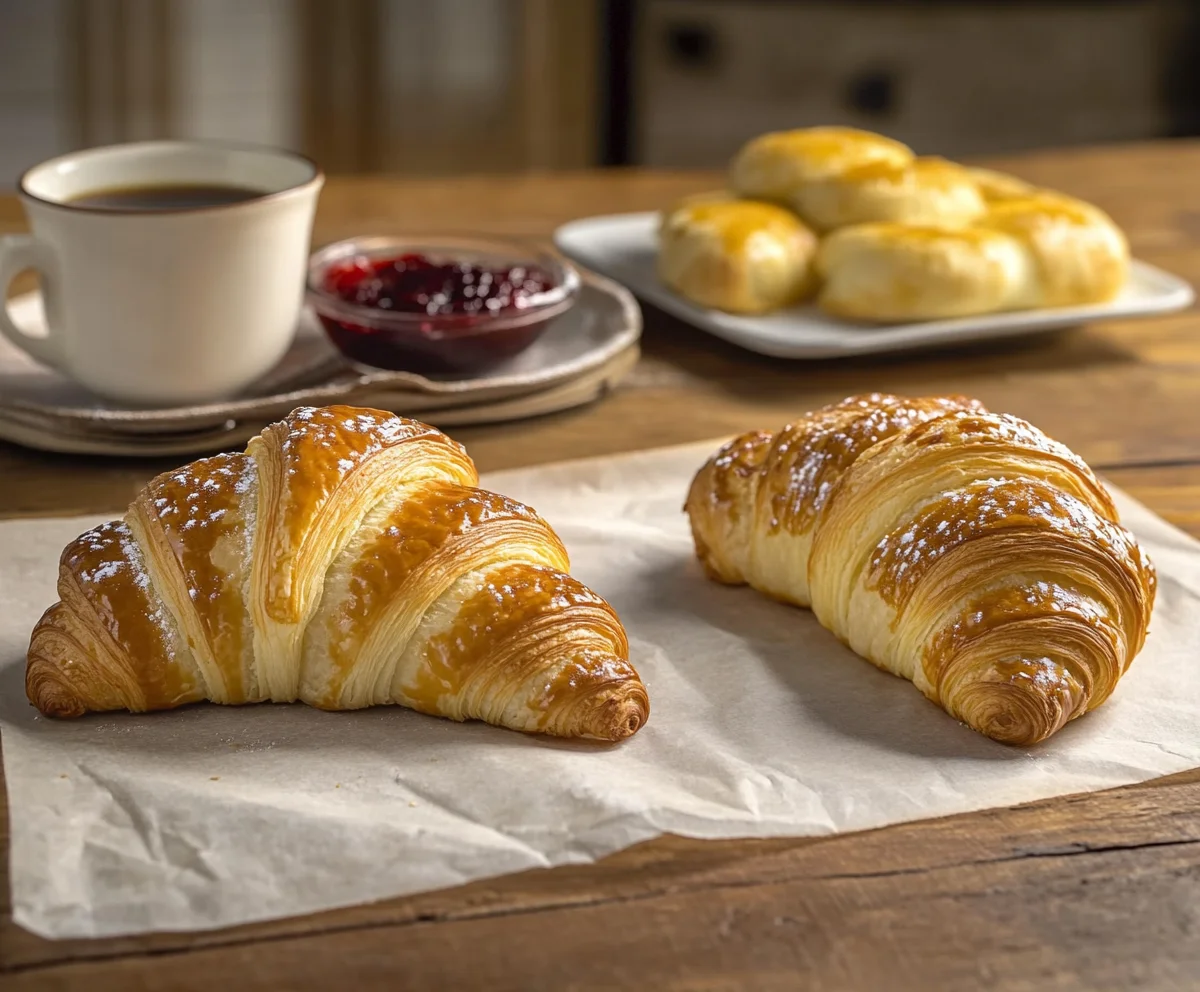Croissants and gipfelis are both iconic, buttery pastries that have become a staple in bakeries worldwide. Despite their similar crescent shapes, these two pastries come from different cultures, each with its own distinctive methods of preparation, flavor profiles, and textures. So, what is the difference between a croissant and a gipfeli? In this article, we’ll dive into their origins, ingredients, preparation methods, and taste to help you better understand these delicious treats.
Origins and History
Croissant
The croissant is widely associated with France, though its roots are actually Austrian. The shape of the croissant is believed to have been inspired by the kipferl, a crescent-shaped pastry originating in Austria. According to legend, the kipferl’s crescent shape symbolized the Ottoman Empire’s defeat after the successful defense of Vienna in the late 17th century.
The croissant as we know it today was refined in France in the 19th century. Austrian baker Sylvain Claudius introduced the kipferl to Paris, and it was gradually transformed into the flaky, buttery pastry that became a breakfast staple in French culture.
Gipfeli
Similar to the croissant, the gipfeli is a crescent-shaped pastry from Switzerland. The name “gipfeli” comes from the Swiss German word for “crescent,” and like the croissant, it shares its origins with the Austrian kipferl. The gipfeli became popular in Switzerland in the 19th century, though it is not as internationally famous as the croissant. It is an integral part of Swiss cuisine, often enjoyed as part of a traditional breakfast or afternoon snack, typically paired with coffee or hot chocolate.
Ingredients
Croissant
The ingredients for croissants include butter, flour, sugar, yeast, salt, and water, but the key to their distinctive texture lies in the laminated dough. This technique involves folding butter into the dough several times, creating thin layers of dough and butter. The result is a flaky, airy texture that croissants are known for. Croissants often contain milk or cream in their dough, which contributes to their richness.
In addition to the classic plain version, croissants come in many varieties, such as pain au chocolat (filled with chocolate), almond croissants (filled with almond paste), and savory versions like ham and cheese croissants.

Gipfeli
Gipfeli dough is quite similar to croissant dough, consisting of butter, flour, yeast, sugar, and salt. However, the primary difference lies in the amount of butter used in the dough—gipfelis tend to use less butter than croissants. As a result, gipfelis are denser and have a more compact texture compared to the lighter, airier croissant. While gipfelis might sometimes contain a small amount of milk or cream, this is not as common as in croissants.
Unlike croissants, gipfelis are usually enjoyed plain or lightly dusted with sugar. While some versions do contain jam or fruit fillings, they are generally simpler and less varied than croissants.
Preparation and Baking Methods
Croissant
Making croissants requires a meticulous process of lamination, which involves folding butter into dough multiple times to create thin, buttery layers. This process can take several hours, as the dough needs time to rest and relax between folds. Once the dough is ready, it is shaped into a crescent and left to rise before baking.
Croissants are baked at a high temperature to achieve their signature golden-brown, crisp exterior and soft, airy interior. The lamination process ensures that croissants are light and flaky, with the butter creating layers that puff up in the oven.
Gipfeli
While the preparation of gipfelis is similar to croissants, it’s generally simpler and faster. The dough is rolled out, cut into triangles, and then rolled into a crescent shape. Gipfeli dough isn’t laminated as many times as croissant dough, which results in a denser texture. After shaping, the dough rises for a shorter time and is typically baked at a slightly lower temperature than croissants.
The baking process results in a pastry with a slightly crispier exterior and a denser, firmer crumb. Though still flaky, gipfelis are not as airy as croissants.
Taste and Texture
Croissant
Croissants are known for their rich, buttery flavor and flaky texture. The lamination process creates thin layers that puff up during baking, making croissants light, airy, and tender. The taste is primarily buttery with subtle sweetness and saltiness. Depending on the filling, croissants can have a wide range of flavors, from sweet chocolate or almond paste to savory ham and cheese.
Gipfeli
Gipfelis share a similar buttery flavor but tend to be slightly less rich and denser compared to croissants. While still flaky, gipfelis have a firmer texture and are less airy. The flavor is typically less sweet than that of croissants, and the dough itself has a more pronounced taste. If topped with a sprinkling of sugar, gipfelis may have a slightly sweeter, crispier crust.
Shape and Appearance
Croissant
The classic croissant is crescent-shaped and can vary in size. Croissants are typically larger than gipfelis and have a soft, fluffy appearance. The golden-brown, flaky crust and soft interior are defining features of the croissant.
Gipfeli
Gipfelis are also crescent-shaped, but they tend to be smaller and more compact. The dough is typically tighter, and they don’t puff up as much as croissants. The crust of a gipfeli is more uniform and can be slightly crispier compared to the croissant’s glossy finish.
Regional Variations
Croissant
Croissants have spread far beyond France and are enjoyed globally. In France, they are often served plain or with butter and jam, while in other countries, you can find variations like chocolate-filled croissants, almond croissants, and even croissants stuffed with savory fillings. In the U.S., croissants are frequently used for sandwiches or made into trendy pastries like cronuts.
Gipfeli
Gipfelis are most commonly found in Switzerland, where they are a quintessential part of the Swiss breakfast. While there are fewer variations of gipfelis compared to croissants, Swiss bakers often prepare them with a light dusting of sugar or fill them with jam. They are also a popular snack to pair with coffee or hot chocolate in Switzerland.
Conclusion
While croissants and gipfelis share a crescent shape and a buttery flavor, their differences lie in their origins, ingredients, preparation methods, and textures. Croissants are known for their light, flaky texture and rich flavor, often featuring a variety of fillings. Gipfelis, on the other hand, are denser, with a firmer crumb and a simpler flavor profile. Whether you prefer the delicate, airy layers of a croissant or the hearty, comforting texture of a gipfeli, both pastries offer a delicious taste of European baking traditions.

